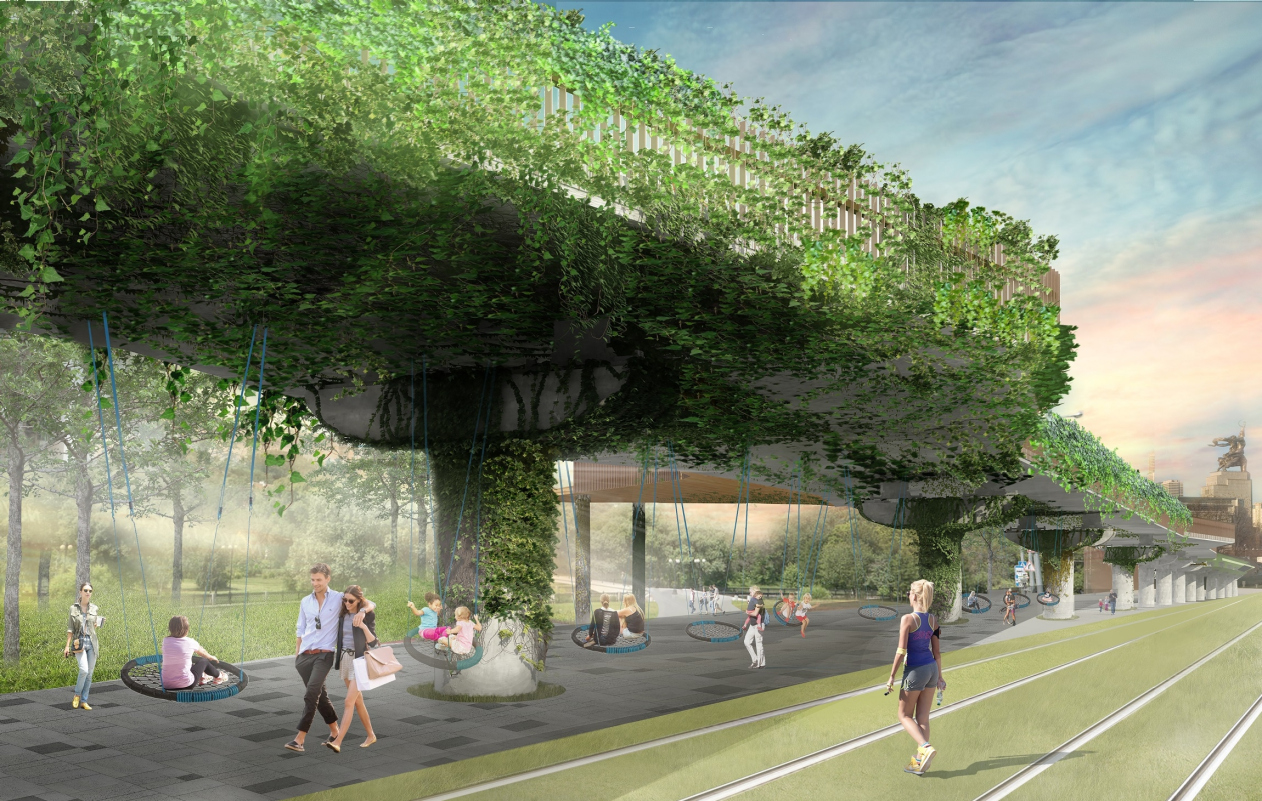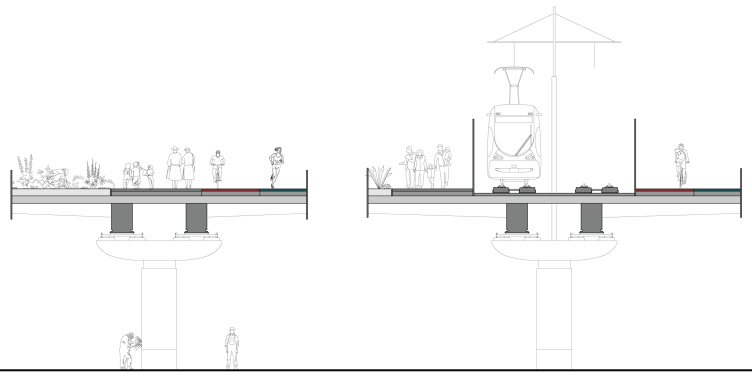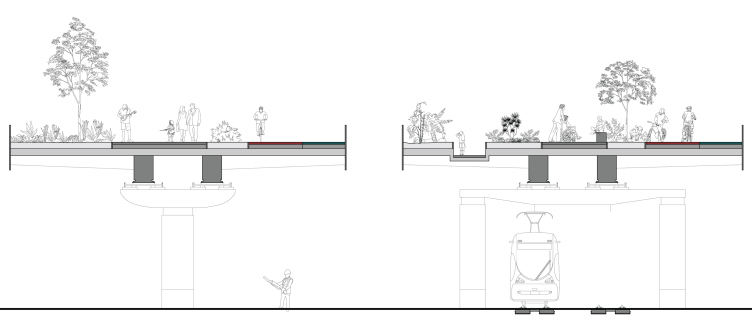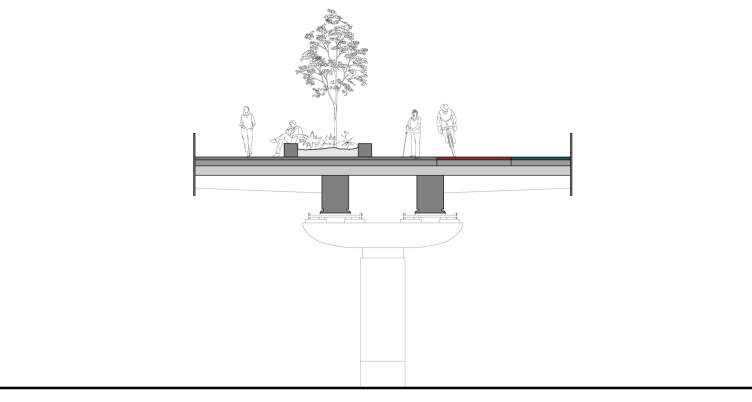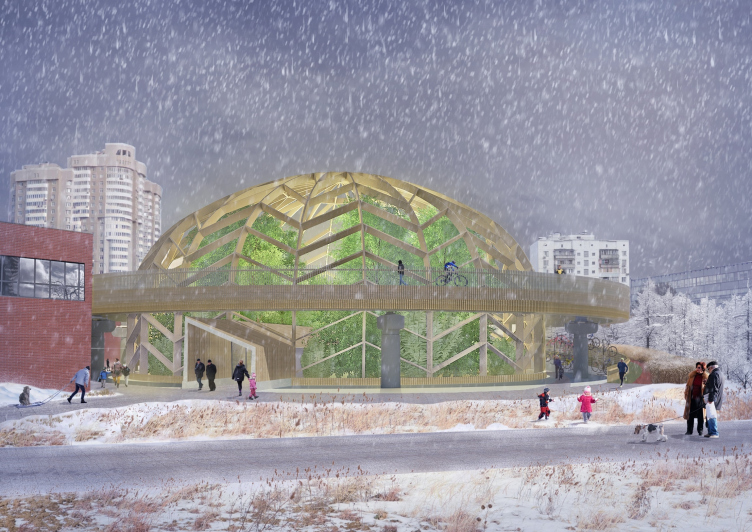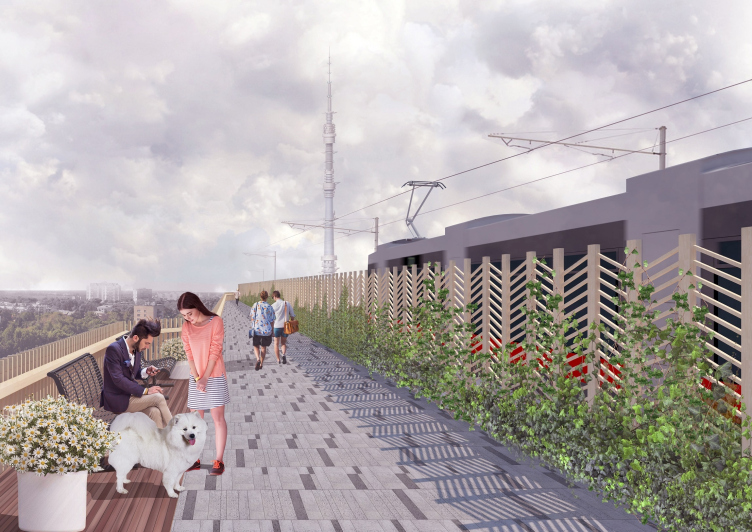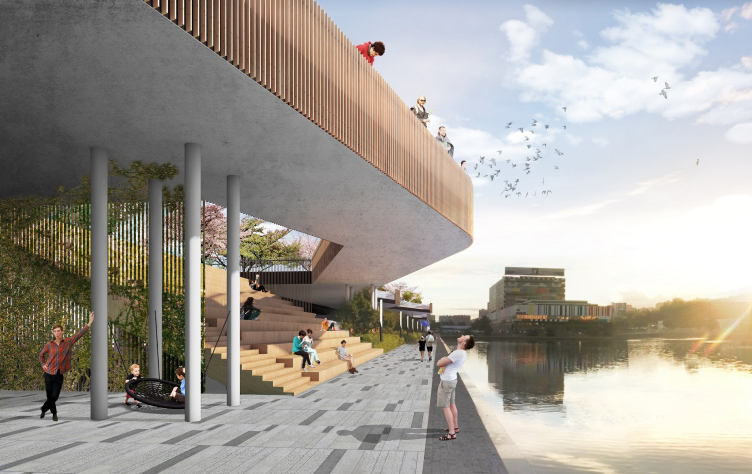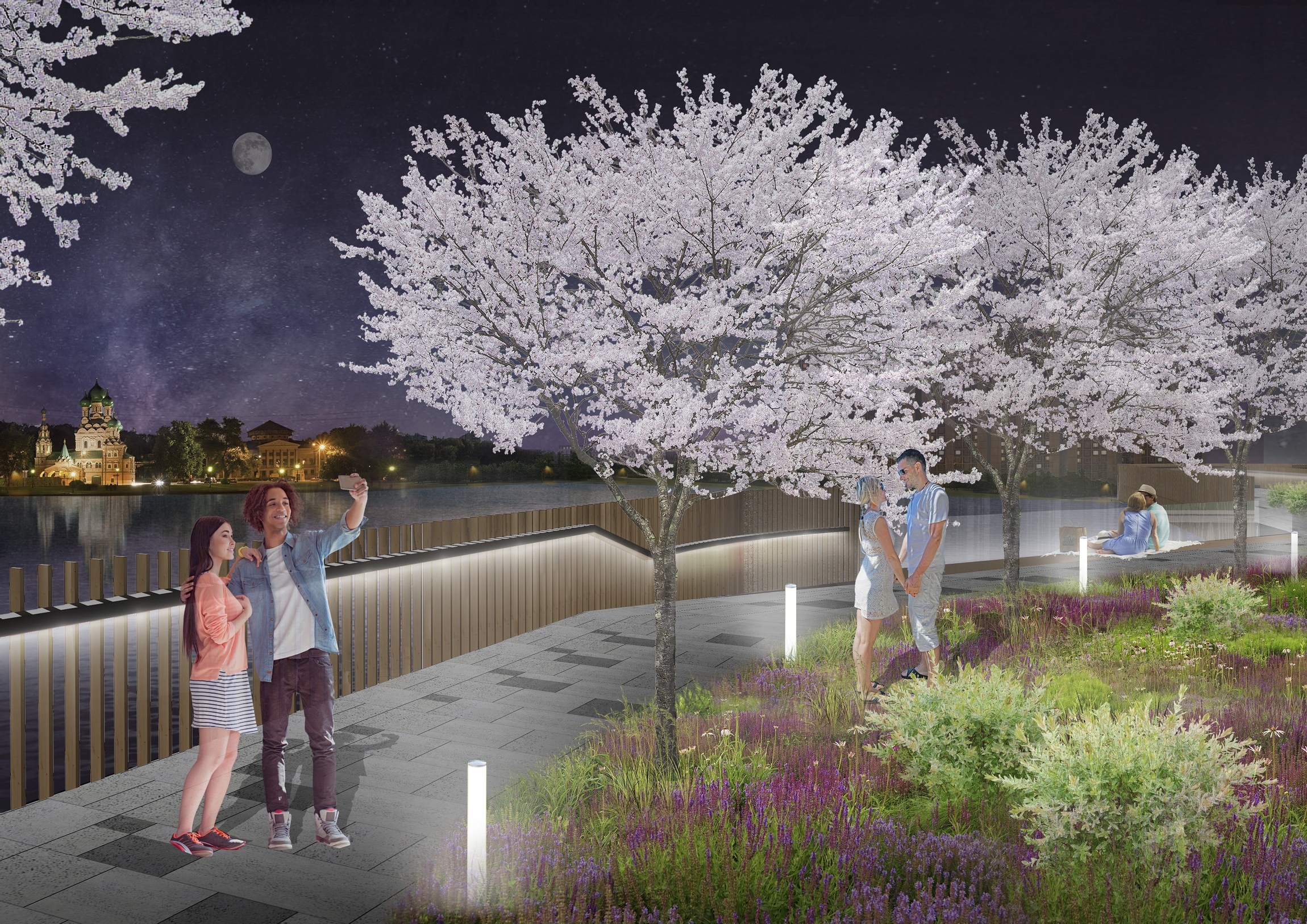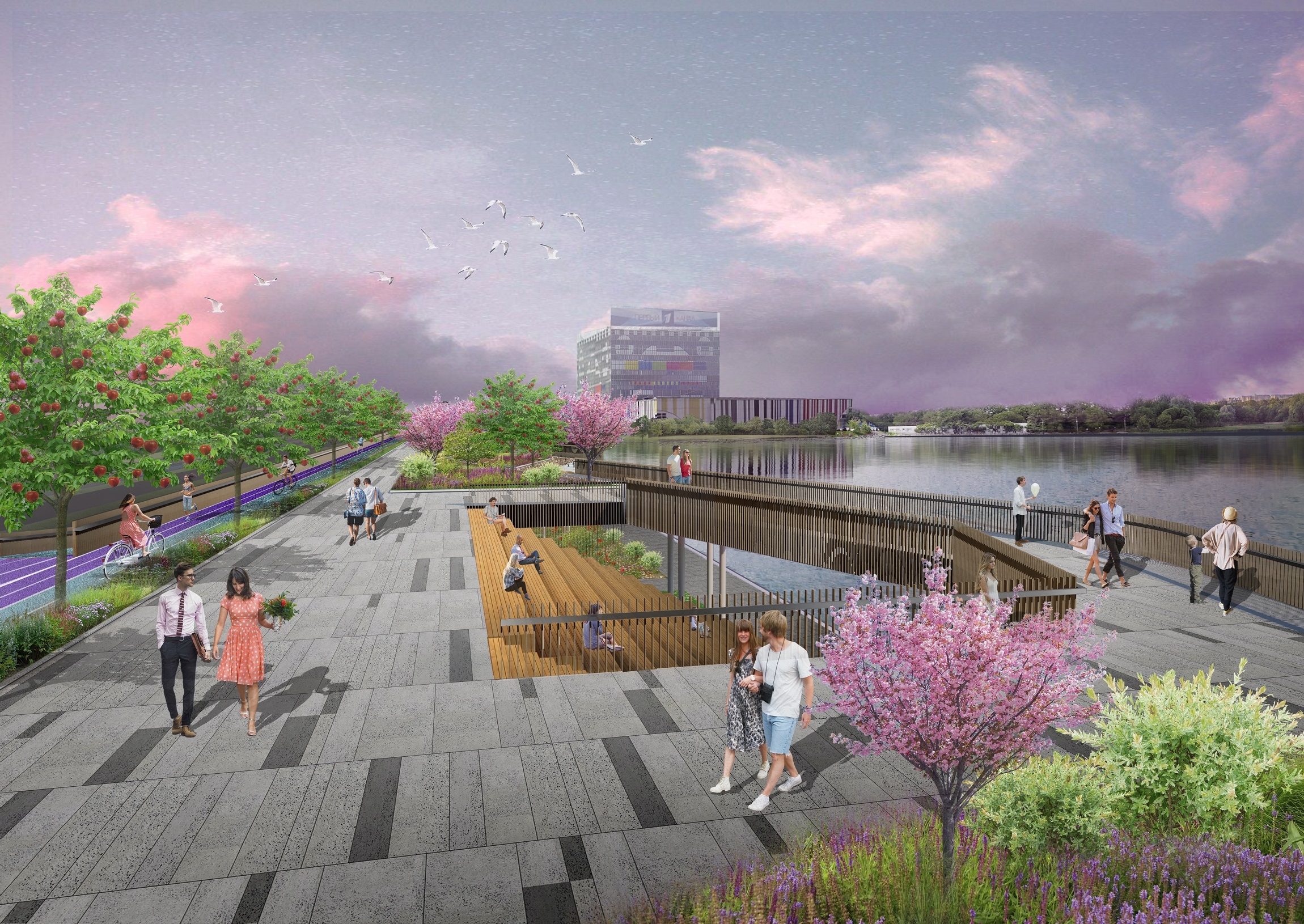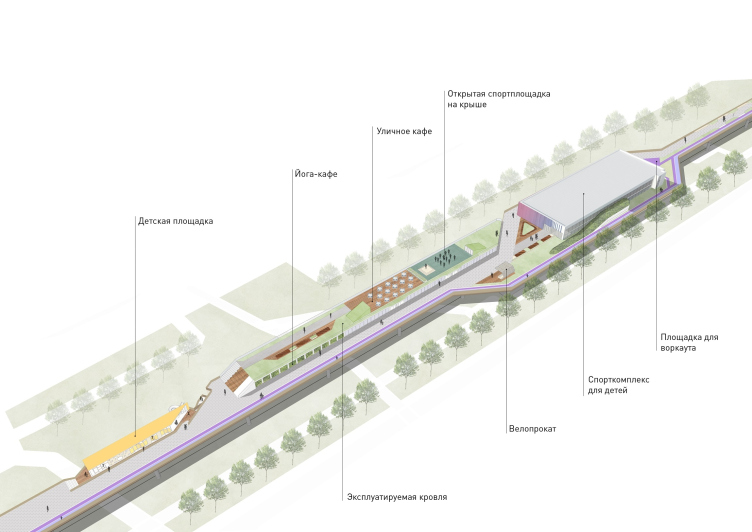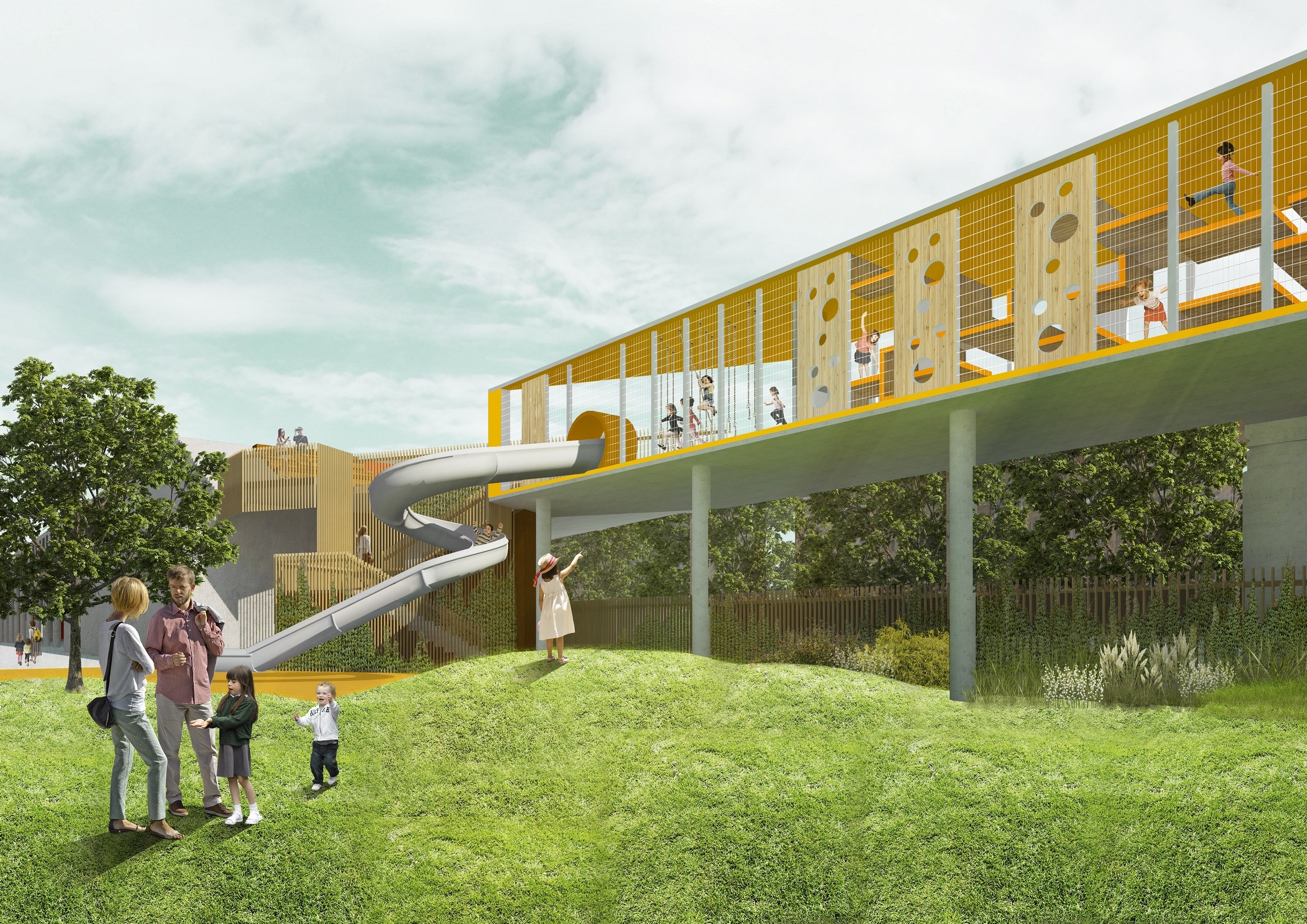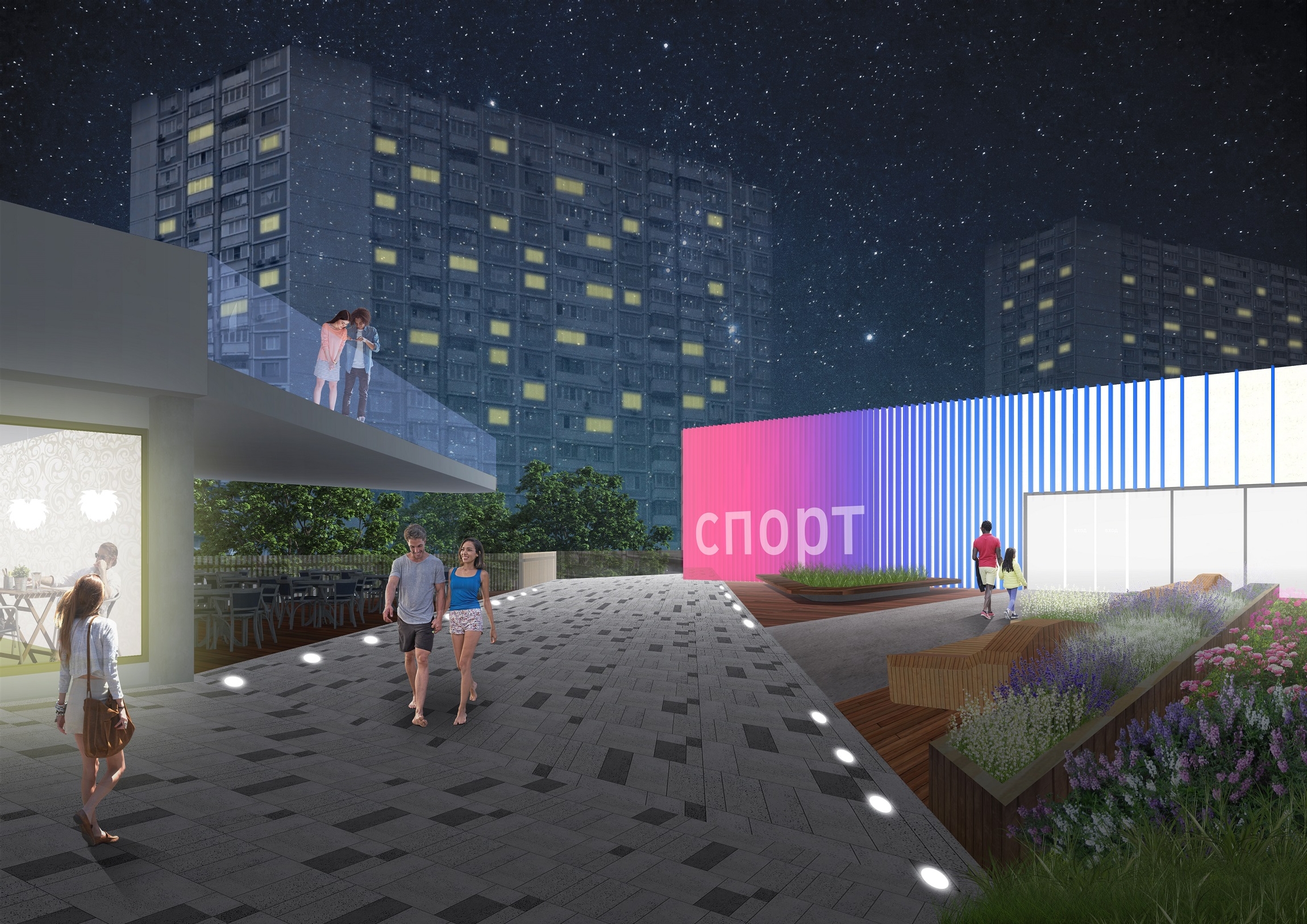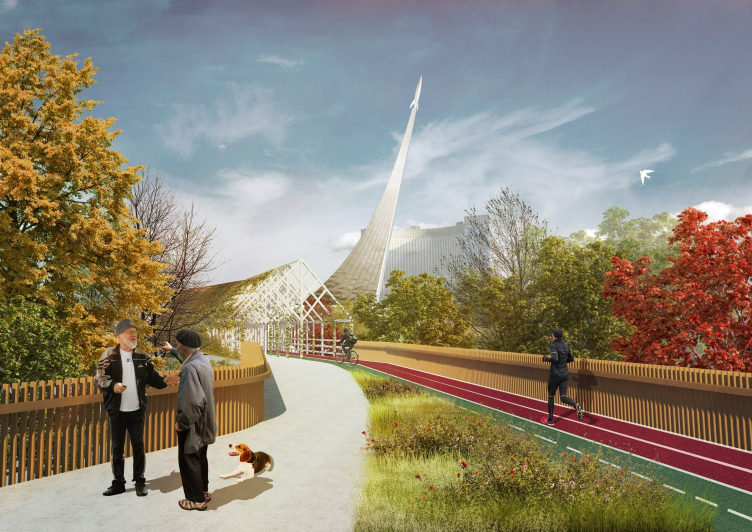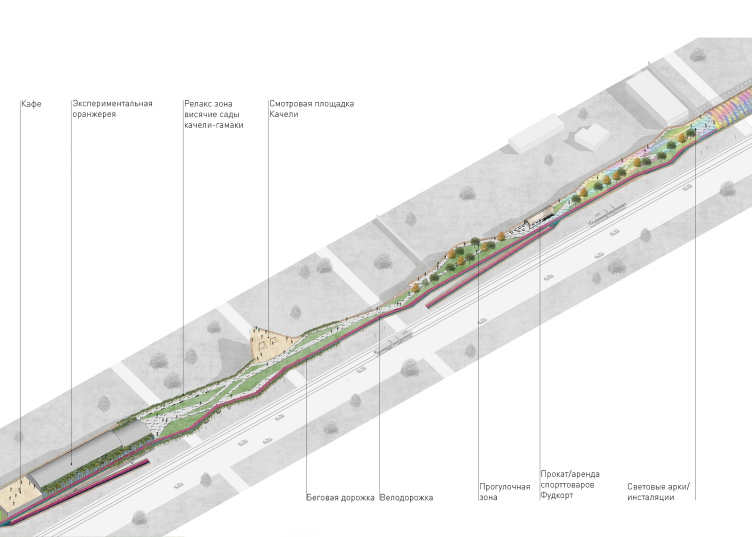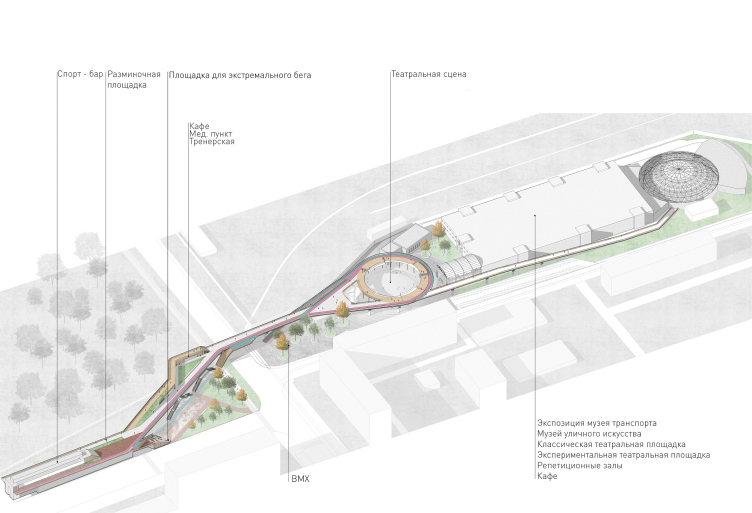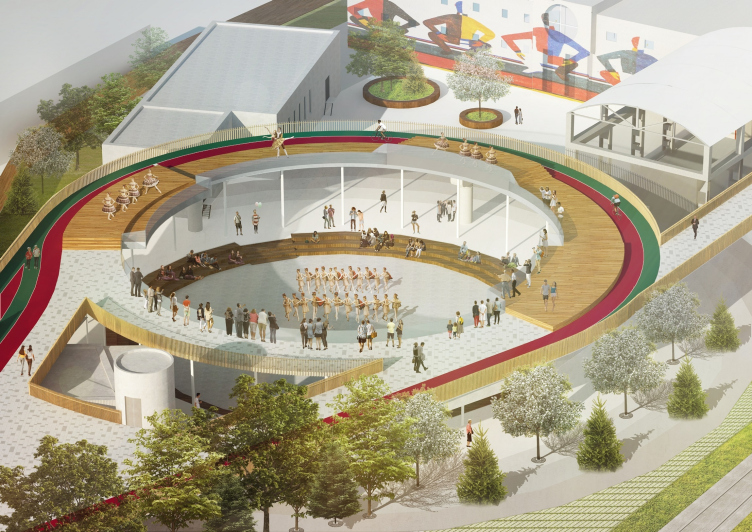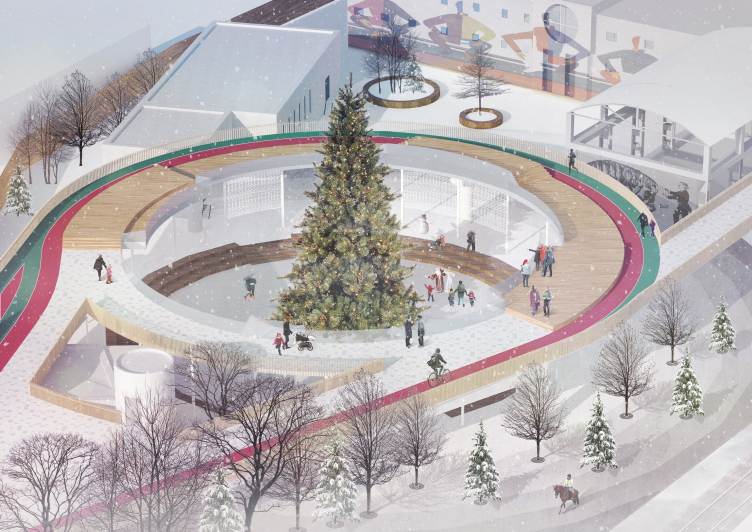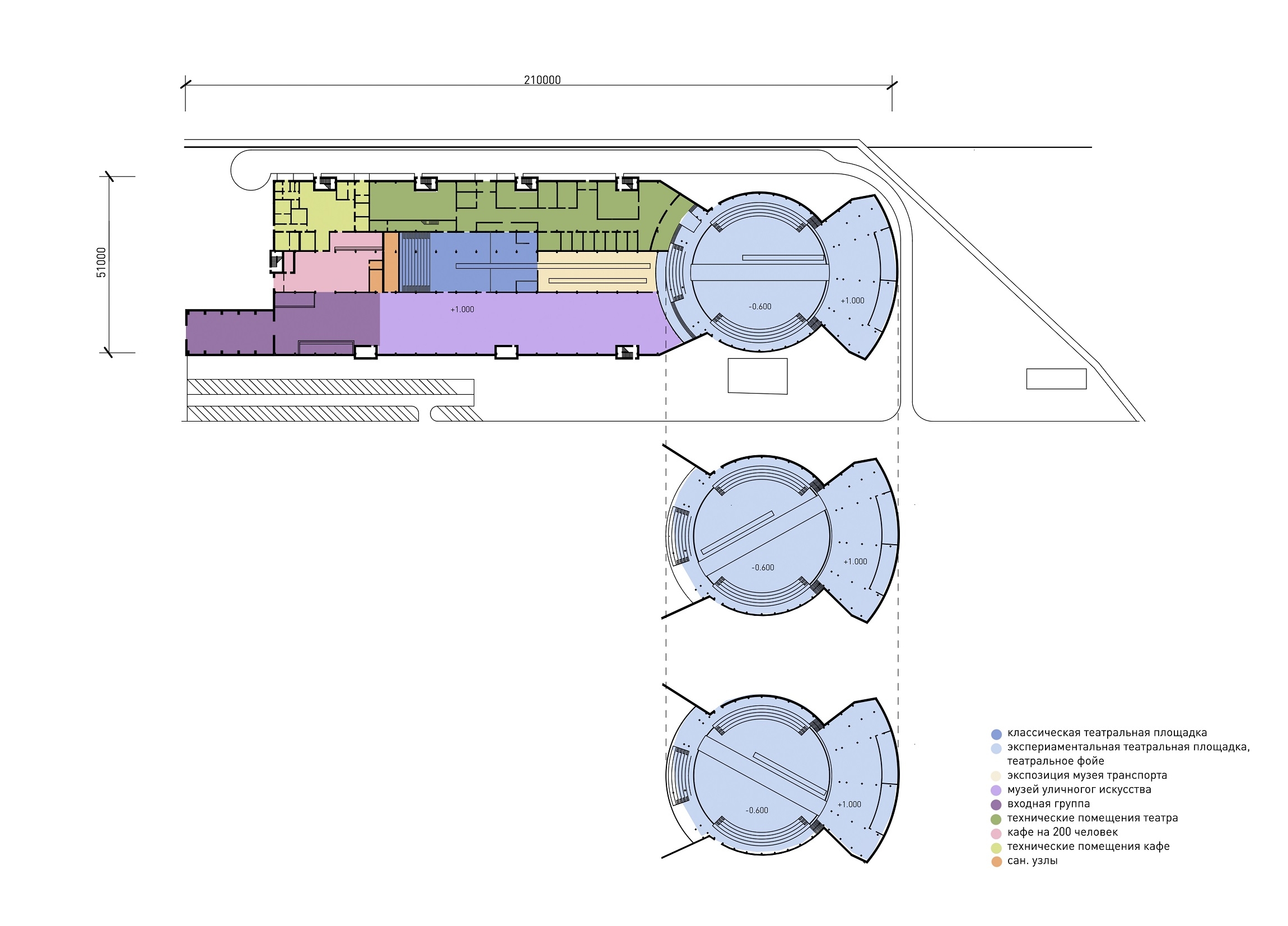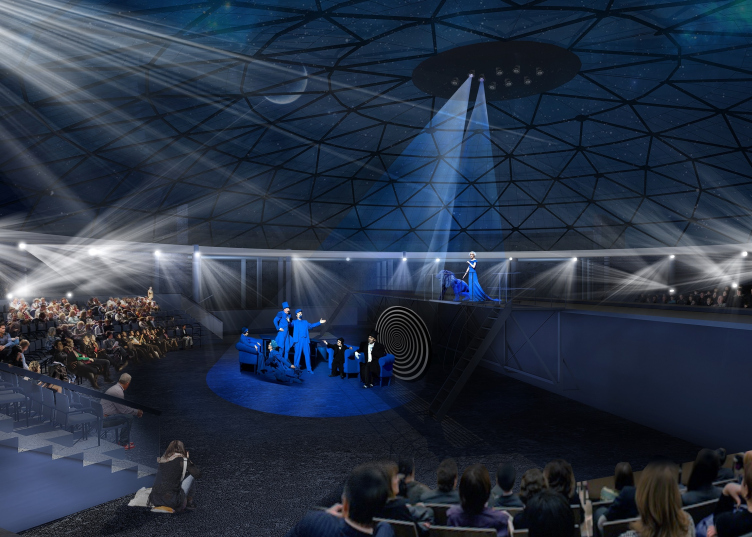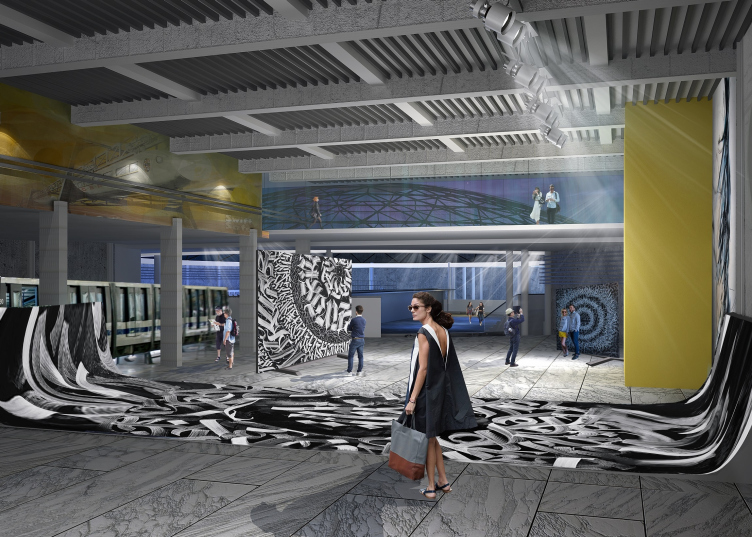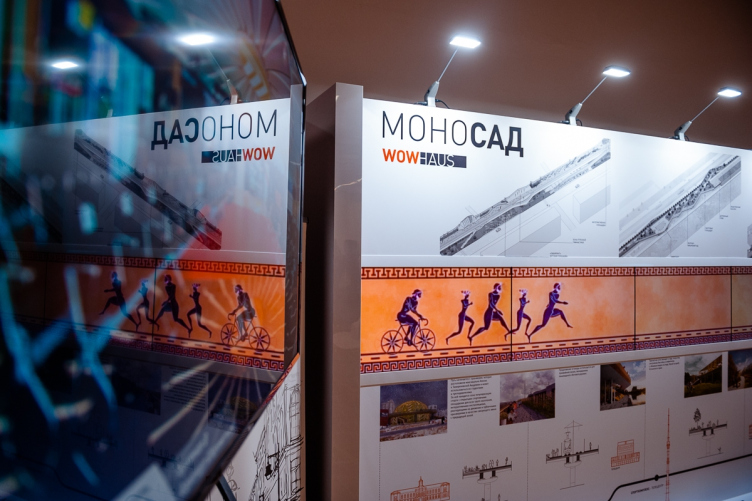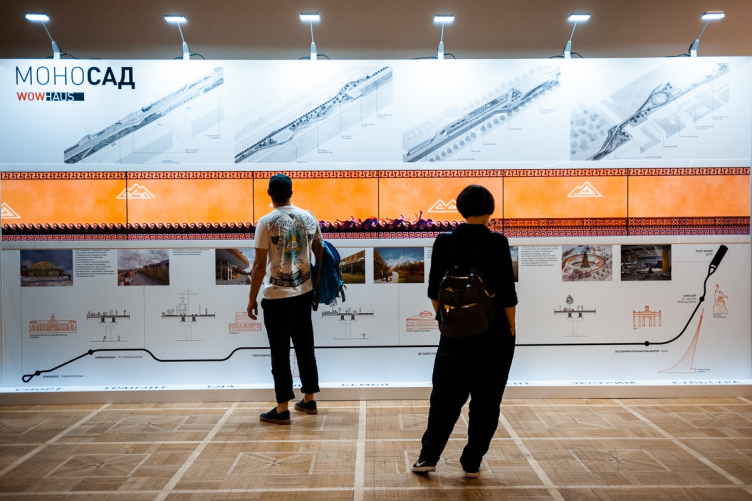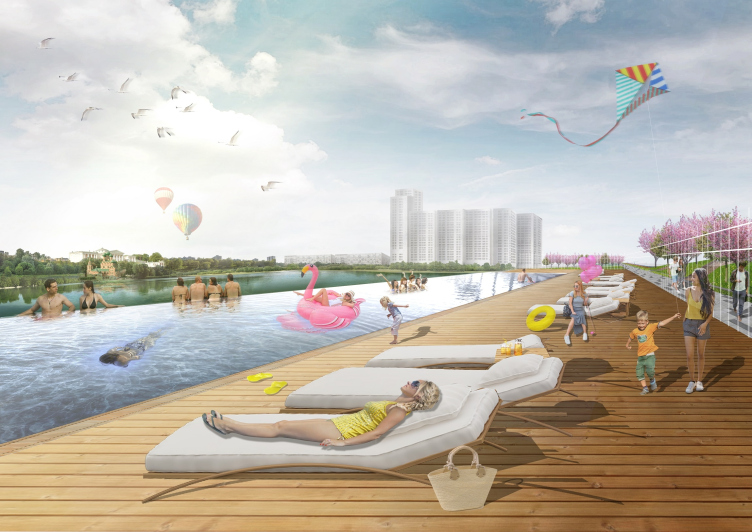According to the architects’ vision, the theme of the park was to be sports – the structure of the park is formed around its jogging and bicycle tracks, and the architects have named their rather peculiar kind of park “the path of health”. But – sports are an obvious matter; there are plenty of various sports facilities around of every conceivable kind nowadays. What makes this project different is the architects’ careful “reading” of the territory and its context, and their stringing various scenarios and functions on the ill-starred metro line. What the architects did was make sure that a walk or a bicycle ride a little over 5 kilometers long should be full of various interesting impressions – yet at the same time they made sure that the new unconventional park should attract those who lives or works nearby.
The town-planning context. "Monosad" project © WOWHAUS
Functional zoning. "Monosad" project © WOWHAUS
The event program. "Monosad" project © WOWHAUS
The architects thought out every detail of the process of reforming all the five kilometers of the overland metro line from the construction and engineering standpoint. Here is the thing: at some places, the monorail tracks run side by side, and at some places they run a few meters apart – what the architects did was connect them with platforms on the inside, adding extra cantilevered platforms on the outside as well, thus dramatically increasing the overall area of the top part. As for the stations – rather large units with broad passenger platforms – the architects also revised them functionally, trying to make the most of their heated and covered premises.
The Monorail starts off at the Timiryazevskaya metro station, where the academic buildings and dormitories of the Timiryazev Agricultural Academy are situated, and this is why at this place the project provides for a greenhouse which is inscribed into the turnaround of the metro line and serves as the starting point of the park.
Functional zoning and potential users. "Monosad" project © WOWHAUS
Section views. "Monosad" project © WOWHAUS
Section views. "Monosad" project © WOWHAUS
The “sleeping belt” residential areas situated between the Timiryazevskaya and Ulitsa Milashenkova stations are treated by the architects as the zone of popularization of sports, designed not so much for professional athletes as for sports enthusiasts of all age brackets, from children to senior citizens: here the architects are placing interactive playgrounds, recreation areas, and, again, a public greenhouse.
The next part of the flyover metro line runs over a railroad track, and, according to one of the versions, the Transportation Department is planning to keep the tram running here. Should this become the case, the architects provided a ramp for the cars to make it over the railroad tracks by way of the fragment of the reformed flyover. This part of the Monorail is in fact a “transient zone” – here the jogging and bicycle trails run parallel to the railway, fenced off from the tram traffic by green espaliers.
Section views. "Monosad" project © WOWHAUS
The greenhouse. "Monosad" project © WOWHAUS
The zone of popularizing sports that crosses the sleeping belt between the Timiryazevskaya and Ulitsa Milashenkova metro stations. "Monosad" project © WOWHAUS
The middle of the Monorail is the Teletsentr (“TV Center”) metro station. The employees of the TV center need recreational areas situated within a walking distance of their workplaces, these recreation areas including walking places, cafes, restaurants, shops, and, possibly, fitness centers – the casual zone that is devised by the architects here includes all these infrastructure projects. Further on, it bleeds into the zone called “Daydream Garden” – a park territory planted with fruit and berry-bearing trees. This place commands a fine view of the Ostankinskaya Church and the Ostashkovskoe Estate, the pond, and the famous Moscow TV-tower, for which the architects have designed sightseeing platforms. In addition to the trees, blossoming in spring and bearing fruit in summer, the garden includes an open-air panoramic swimming pool having no analogues in Moscow – the swimmers will actually be able to get to the edge and look at the Ostankinskiy Pond from up above.
The garden is continued by a family recreation zone. The “Ulitsa Akademika Koroleva” station – a rather large building with a rectangular plan – is turned by the authors into a sports kindergarten, which becomes the nucleus of this zone. Next to it, there is a recreation center and a parents’ waiting lounge, with cafés and restaurants, including those situated on the roof; these are meant to ensure the inflow of visitors in the evening. Further on, the theme of a sports center is picked up by a two-level playground with a roof that protects it from the rain.
The transient zone. "Monosad" project © WOWHAUS
The zone of the Ostankino Pond. "Monosad" project © WOWHAUS
Above the Ostankino Pond. "Monosad" project © WOWHAUS
The attention of those going for a stroll around the All-Russia exhibition center will be attracted by the lush vegetation in the experimental greenhouse – the architects are turning the former Vystavochny Tsentr station into it. The plants “spill over” and entwine around the structures of the Monorail like a jungle – as if the nature had broken loose from the anthropogenic control and seized the flyover altogether. The narrative is augmented by lighting installations – currently, the project presents them as rainbow arches.
Next comes the zone of professional sports: venues for power lifting, workout, extreme sports, gyms, and a first medical aid point. The sports area then gives way to the cultural one – the final part of the park.
The Daydreaming Garden. "Monosad" project © WOWHAUS
The Daydreaming Garden. "Monosad" project © WOWHAUS
"Monosad" project © WOWHAUS
According to the project, the building of the former depot of the Monorail, behind the Ulitsa Sergeya Eisensteina, close to the the All-Russian State Institute of Cinematography, hosts experimental theater venues with turntable stages. The building will also include a museum of graffiti and street art, combining it with a museum of transport that has lost its home. The idea to use the exhibits of the museum as a canvas will help to combine the art and the transport expositions.
It is worth mentioning that the idea of turning an outdated monorail into a hanging garden is not exactly groundbreaking – after the Zaryadye Park was opened you will hardly find a Muscovite who has not heard about New York’s Highline park, and that’s the first thing that comes to mind. The similarity to the famous DS+R park on rails is also apparent – meanwhile, the authors of the project neither deny nor highlight it, reminding us that the first “hanging garden” in history built on an old railway was the Parisian park La Coulée verte, that was made in 1988-1993. On the other hand, as the authors of the project admit, they were more inspired by the example of the Seoul park Skygarden, which was built by MVRDV in 2015-2017.
The family recreation zone. "Monosad" project © WOWHAUS
The family recreation zone. "Monosad" project © WOWHAUS
The family recreation zone. "Monosad" project © WOWHAUS
This project is essentially an urbanist research work that combines the upbeat spirit of sports with passeism, the inevitable companion of urban meditation. Combining these things, not quite related to each other – the young and the old, the joyful and the pensive, the pragmatic and the melancholy, which invites the observer to read the many meanings, and at the same time is not at odds with the direct pragmatic use has recently become one of the trademark techniques of this architectural firm.
The Monogarden was first presented at Arch Moscow in May of 2018; recently it also got shortlisted for the WAF prize.
The zone next to the All-Russia Exhibition center. "Monosad" project © WOWHAUS
The experimental greenhouse. "Monosad" project © WOWHAUS
The zone next to the All-Russia Exhibition center. "Monosad" project © WOWHAUS
Professional sports zone. "Monosad" project © WOWHAUS
The of the All-Russia Exhibition center that completes the turnaround with a theater stage. "Monosad" project © WOWHAUS
The of the All-Russia Exhibition center that completes the turnaround with a theater stage. "Monosad" project © WOWHAUS
The zone of the All-Russia Exhibition center that completes the turnaround with a theater stage. "Monosad" project © WOWHAUS
The depot floor plan. "Monosad" project © WOWHAUS
The zone of the All-Russia Exhibition center that completes the turnaround with a theater stage. "Monosad" project © WOWHAUS
The zone of the All-Russia Exhibition center. "Monosad" project © WOWHAUS
Presentation of the "Monosad" project at Arch Moscow 2018 © WOWHAUS
Presentation of the "Monosad" project at Arch Moscow 2018 © WOWHAUS
The swimming pool. "Monosad" project © WOWHAUS
